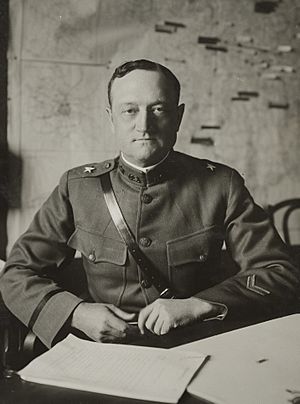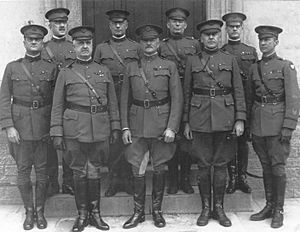Harold Benjamin Fiske facts for kids
Quick facts for kids
Harold Benjamin Fiske
|
|
|---|---|

Brigadier General Harold Fiske in September 1918 in Chaumont.
|
|
| Born | November 6, 1871 Salem, Oregon, US |
| Died | May 1, 1960 (aged 88) San Diego, California, US |
| Allegiance | |
| Service/ |
|
| Years of service | 1897–1935 |
| Rank | |
| Service number | 0-551 |
| Unit | |
| Commands held | Panama Canal Department Panama Canal Division 87th Infantry Division |
| Battles/wars | Spanish–American War
Moro Rebellion
|
| Awards | Distinguished Service Medal Silver Star Croix de Guerre Legion of Honour Order of Leopold Order of the Crown of Italy |
| Spouse(s) | Lucy Brooks |
| Children | 2 |
Harold Benjamin Fiske (born November 6, 1871 – died May 1, 1960) was a highly respected officer in the United States Army. He reached the high rank of major general. Fiske was a hero in several wars, including the Philippine–American War and World War I. During World War I, he was a key leader in training American soldiers.
After the war, he continued his service in the Army. He retired in 1935 as a major general, having been in charge of the Panama Canal Department.
Contents
Early Life and Military Start
Harold B. Fiske was born on November 6, 1871, in Salem, Oregon. He went to Bishop Scott Academy in Portland, Oregon, and finished in 1891. After teaching for two years, he joined the United States Military Academy at West Point, New York in June 1893. While at West Point, he played football and was the Vice-President of his class.
Fiske graduated in June 1893 with a science degree. He became a second lieutenant in the Infantry Branch. His first assignment was with the 18th Infantry Regiment in Fort Sam Houston, Texas.
Serving in the Philippines and Cuba
In June 1898, Fiske's regiment went to the Philippines. He fought against the Spanish during the Battle of Manila. When the Philippine–American War started in February 1899, Fiske helped defend Manila against Filipino fighters. He stayed in the Philippines until August 1901. For his brave service there, he received the Silver Star medal.
After a short time back in the United States, Fiske returned to the Philippines in May 1902. He continued fighting until December 1903. He then came back to the U.S. and became a captain.
Later, Fiske was sent to Cuba in 1906. The U.S. military was there to help keep peace and set up new elections. He stayed in Cuba until February 1909, when American troops left.
Becoming an Instructor and Advisor
After Cuba, Fiske studied at important Army schools in Fort Leavenworth, Kansas. He graduated with honors from both the Army School of the Line and the Army Staff College. He then taught at these schools until November 1914. During this time, he also took part in the Veracruz Expedition in Mexico.
Fiske went back to teaching at the Army Staff College in Washington, D.C.. He stayed there until April 1917. He believed in making infantry tactics better. For example, he suggested making infantry companies larger and using more grenades. He also thought the U.S. Army should learn from other armies' experiences in Europe. In 1916, he worked with General John J. Pershing on the Mexican border and became a major.
World War I Service

When the United States joined World War I, Fiske went to France in June 1917. He was promoted to lieutenant colonel and joined the Training Section (G-5) of the American Expeditionary Forces (AEF). The AEF was the main American army fighting in Europe, led by Major General John J. Pershing.
Fiske became the chief of the Training Section in February 1918. He was in charge of making sure American soldiers were well-trained for battle. He believed all officers should attend special training schools in France. Sometimes, units arriving in France had their officers sent to these schools, which made it harder for them to fight right away.
General Pershing saw Fiske as a very skilled officer. He promoted him to brigadier general in June 1918. Fiske also volunteered to serve with different infantry divisions during major battles. He fought in the Battle of Saint-Mihiel, the Second Battle of the Marne, and the Meuse-Argonne Offensive. His experiences in these battles helped him improve the AEF's training system even more.
For his great service in France, Fiske received the Army Distinguished Service Medal. He also earned several awards from other countries, including:
- The Legion of Honour from France
- The French Croix de Guerre
- The Order of Leopold from Belgium
- The Order of the Crown of Italy from Italy
After the War
Fiske returned to the United States in August 1919. He went back to his peacetime rank of major. He became an instructor at the United States Army Infantry School in Fort Benning, Georgia. A few months later, he was promoted to lieutenant colonel.
When General Pershing became the Chief of Staff of the U.S. Army in July 1921, Fiske was transferred to the War Department General Staff. He was put in charge of the Training Section again. He was promoted to brigadier general in 1922. In December 1924, he took command of the 4th Infantry Brigade in Fort Sam Houston, Texas.
In June 1927, he commanded the 3rd Infantry Brigade. Later, he joined the staff of the Fourth Corps Area in Fort McPherson, Georgia. In April 1930, he took command of the 87th Infantry Division, which was a reserve unit for Louisiana, Alabama, and Mississippi.
Panama Canal Zone
In April 1931, Fiske was sent to the Panama Canal Zone. He became the commanding general of the Panama Canal Division. His job was to protect the Atlantic side of the Panama Canal. He was promoted to major general in August 1933 and took command of the entire Panama Canal Department. This meant he was responsible for the complete defense of the Panama Canal Zone.
Fiske retired from the Army on November 30, 1935, after 38 years of service.
Retirement and Legacy
After retiring, Harold Fiske lived in San Diego, California. He was involved in groups for retired officers. He passed away on May 1, 1960. He was buried with full military honors at Fort Rosecrans National Cemetery. His wife, Lucy Beatrice Keyes, is buried next to him. They had two daughters, Virginia and Berenice. Virginia later married Major General Thomas S. Timberman.
Awards and Decorations
Here are some of the awards Major General Fiske received:
| 1st Row | Army Distinguished Service Medal | Silver Star | |||||||
|---|---|---|---|---|---|---|---|---|---|
| 2nd Row | Spanish Campaign Medal | Philippine Campaign Medal | Army of Cuban Occupation Medal | ||||||
| 3rd Row | Mexican Service Medal | World War I Victory Medal with five Battle Clasps | Legion of Honour, rank Commander | ||||||
| 4th Row | French Croix de guerre 1914-1918 with Palm | Belgian Order of Leopold, rank Commander | Order of the Crown of Italy, rank Commander | ||||||
Images for kids
See also
| Military offices
|
||
|---|---|---|
| Preceded by Preston Brown |
Commanding General, Panama Canal Department September 5, 1933 – November 10, 1935 |
Succeeded by Lytle Brown |
| Preceded by Charles DuVal Roberts |
Commanding General, Panama Canal Division April 3, 1931 – April 15, 1932 |
Succeeded by Command dissolved |

